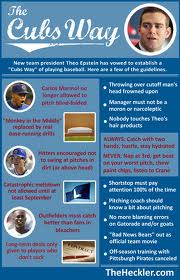 This last weekend I attended the Chicago Cubs Convention with my family. As we drifted from session to session, I couldn’t help but see all sorts of blog themes and things that non-profit organizations could learn from this major league franchise. I will use the next few days to share a few of these observations and hopefully stimulate a few new ideas for you and your agency. In yesterday’s post, we talked about stewardship. Today, I thought we could talk about shared vision, values, and culture.
This last weekend I attended the Chicago Cubs Convention with my family. As we drifted from session to session, I couldn’t help but see all sorts of blog themes and things that non-profit organizations could learn from this major league franchise. I will use the next few days to share a few of these observations and hopefully stimulate a few new ideas for you and your agency. In yesterday’s post, we talked about stewardship. Today, I thought we could talk about shared vision, values, and culture.
In many of the sessions, it wasn’t uncommon for someone to reference something called “The Cubs Way Guide“. They always described this guide as an organizational manual that describes what they believe and how they do things. Here is how President of Baseball Operations Theo Epstein described “The Cubs Way Guide” in February 2012 on the Cubs’ website:
“The Cubs’ way really boils down to the people — the players, obviously, but everyone, all the scouts and all the people in uniform in the Minor Leagues and the big leagues. For us to teach the game the right way, it’s more than words on the page. It comes down to how deep we dig to get connected to players to teach the game the right way, how much we care, how committed we are, how hard we work. There’s a lot that goes into this and building an organization.”
At Saturday’s convention, here are some of the phrases I heard people use to describe this manual and organizational resource:
- It is a document that is a few inches thick.
- It is what we believe as an organization.
- It embodied the organization’s philosophy and approach.
- It spells out how to prepare players for the big leagues.
- It lays out for coaches at every level of the minor league and major league how to teach players how to play the game. Instruction can get as detailed as which foot hits the bag when players make a turn on the bases.
- It lays out a vision and plan.
I walked away from each of these sessions wondering the same thing: “I wonder what such a manual might look like for a non-profit organization?”
 After a few days of day dreaming about this topic, here are a few of my thoughts on what your organizational guide might contain:
After a few days of day dreaming about this topic, here are a few of my thoughts on what your organizational guide might contain:
- Shared values
- Shared vision
- Code of ethics
- Conflict of interest policies
- Protocol on how to recruit community volunteers and prepare/position them for joining the board some day. (e.g. getting them involved in a committee, working a few pledge cards, etc)
- Procedures on how to identify, cultivate, recruit, orient, train, rotate, recognize, and evaluate board volunteers.
- Steps on how to hire new staff.
- Rules on how to conduct outreach/recruitment of clients.
- Etiquette on how to prepare for board meetings and committee meetings (e.g. agendas sent out a certain number of days before the meeting, meeting notes and action item memos going out a certain number of days after a meeting, elements of a productive board meeting, etc)
- Code of behavior regarding how to engage, solicit and communicate with donors (e.g. Donor Bill of rights)
I suspect that I could make this list go on and on and on if I wanted.
If you started thinking to yourself when reading my list that you already have some of this in place at your organization, I suspect you are probably on to something. Some of this might already be included in your strategic plan, board development plan, resource development plan, stewardship plan, etc.
However, the genius of “The Cubs Way Guide” is:
- It is all in one place, not in a series of documents sitting on a number of different book shelves.
- It creates a central focus. It becomes the heartbeat of your organizational culture.
- It is easy to reference.
- It is easy to create training opportunities around it.

What are your thoughts about creating an organizational “How To Manual” for your non-profit organization? What would you include? Who would you involve in this project? What elements already exist that you might fold into such a manual? How would you use it to transform your organizational culture? Please use the comment box below to share your thoughts because there is nothing new under the sun and we can all learn from each other.
Here’s to your health!
Erik Anderson
Founder & President, The Healthy Non-Profit LLC
www.thehealthynonprofit.com
erik@thehealthynonprofit.com
http://twitter.com/#!/eanderson847
http://www.facebook.com/eanderson847
http://www.linkedin.com/in/erikanderson847

One comment